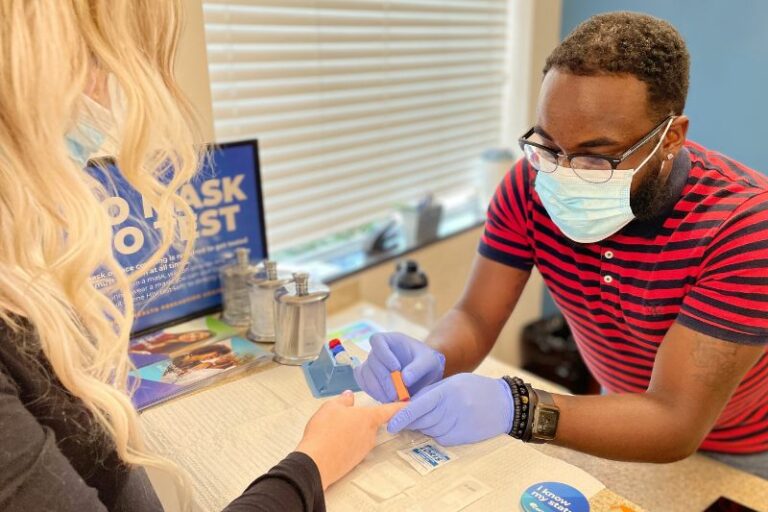Let’s clear a few things up
Even though it’s been more than 40 years since HIV was first identified in the US, a lot of misinformation is still floating around. And that misinformation—combined with stigma, fear and judgment—continues to harm people today.
If you didn’t grow up hearing about the early days of the HIV crisis, it might feel like something that’s not really relevant anymore. But it is. In fact, young adults (ages 18–34) make up the largest share of new HIV diagnoses in the US right now.
So why is this still happening? For a lot of reasons:
- Many people don’t think HIV could affect them.
- Stigma and discrimination make it hard to talk openly about sex, drug use or getting tested.
- There’s still a lot of confusion about how HIV is actually transmitted—and what it means to live with it today.
Let’s start by busting some of the biggest myths. Whether you’ve believed these yourself or just heard them from someone else, it’s time to get the facts straight.
Myth: HIV and AIDS are the same thing.
HIV is the virus that can lead to AIDS (Acquired Immunodeficiency Syndrome). Not everyone with HIV develops AIDS. With proper treatment, many people with HIV can live long, healthy lives without ever developing AIDS. Want to know more? Check out HIV: The Basics.
Myth: HIV can be spread through casual contact.
HIV is not transmitted through casual contact such as kissing, hugging, shaking hands, sharing food, touching surfaces or using the same toilet. You cannot get HIV from saliva, urine, insect bites, donating blood or using public bathrooms. The virus is primarily spread through specific bodily fluids, including blood, semen, vaginal or anal fluid, and breastmilk.
Myth: It’s impossible to know exactly how HIV spreads.
Not true! HIV is most commonly transmitted through specific activities like sharing needles and having unprotected sex with someone who has untreated HIV. Knowing the facts about HIV transmission helps reduce risk and stop stigma.
Myth: Only certain groups of people are at risk for HIV, such as gay men.
HIV can affect anyone, regardless of age, gender, sexual orientation or ethnicity. Some activities, behaviors, or conditions can put people at greater risk for HIV. Risk factors include unprotected vaginal or anal sex, having another STI, sharing needles and exposure to contaminated blood products, not a person’s identity or background.
Myth: You can tell if someone has HIV by looking at them.
You cannot identify people living with HIV by just looking at them. You also cannot identify people who are HIV-positive by their symptoms alone. (HIV may not show any symptoms for years.) The only way to know if someone has HIV is through testing provided at a doctor’s office, clinic or other testing locations, like Caracole, or through an HIV self-test kit. Want to know more? Check out HIV Testing.
Myth: HIV is a death sentence.
Although there is no cure for HIV (yet), antiretroviral therapy (ART) can control the virus, enabling people to live long, healthy lives and reducing the risk of transmission. Early diagnosis and consistent treatment are crucial for managing the virus effectively.
Myth: You can’t get HIV if you’re in a monogamous relationship.
While a mutually monogamous relationship where both partners are HIV-negative reduces the risk, it doesn’t eliminate it. It’s essential for both partners to get tested and know their HIV status. Want to know more? Check out Healthy Sex.
Myth: Condoms don’t prevent HIV.
When used correctly and consistently, condoms are highly effective in reducing the risk of HIV transmission during sex. Want to know more? Check out Condom Use Tips.
Myth: If you are taking PrEP, you don’t need to use condoms.
While PrEP (pre-exposure prophylaxis) protects people who could be at risk for HIV it does not protect against other STIs or prevent pregnancy. Always consider using condoms for every sexual contact to protect yourself from STIs. Want to know more? Check out STIs.
Myth: HIV can lead to infertility.
HIV does not affect fertility. In fact, people living with HIV are able to get pregnant, have a healthy pregnancy and delivery when taking HIV medications during the pregnancy and after childbirth. For a pregnant person who takes their HIV medications as prescribed and who has an undetectable viral load, the risk of mother-to-child transmission (MTCT) is less than 1%.
Myth: You can only get HIV from sharing needles if you’re using drugs.
While sharing needles for drug use is a common mode of HIV transmission, any needle sharing—such as tattoo needles or improperly sterilized medical equipment—can spread the virus. Disposing of used syringes in sharps containers is important to reducing accidental transmissions. Want to know more? Check out Safer Use Tips.
Myth: People living with HIV who have an undetectable viral load can still transmit the virus.
When someone is on treatment and maintains an undetectable viral load, they cannot transmit HIV sexually. This is known as U=U, or Undetectable = Untransmittable. Want to know more? Check out U=U.
Myth: Managing diabetes is easier than managing HIV.
Not necessarily. Managing diabetes often involves continuous blood sugar monitoring, dietary changes and lifestyle adjustments, which can be more complex than managing HIV. With proper treatment and adherence to medications, people living with HIV can maintain undetectable viral loads and live healthy lives.
Dispelling these myths matters
The more we challenge misinformation, the easier it becomes to reduce stigma and have real, honest conversations about HIV. Knowing the facts helps us look out for each other, support those living with HIV, and make informed choices about our own health. Awareness, empathy, and education are powerful tools. Let’s use them.



